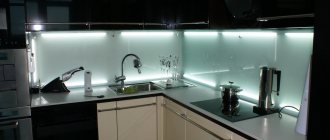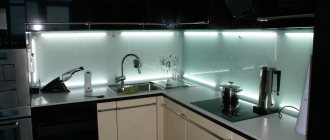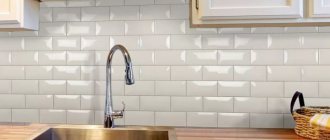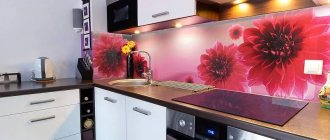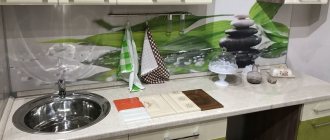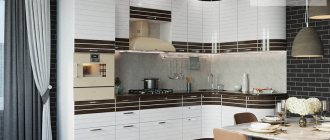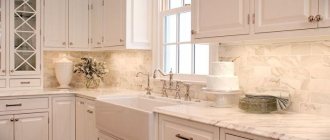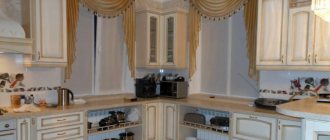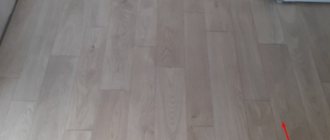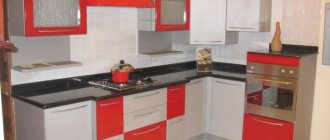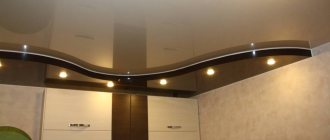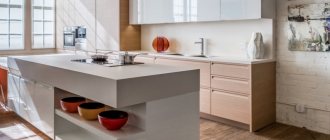It’s very easy to diversify your kitchen interior and make the design brighter and more attractive - just add one decorative accent to it. Any room, even one furnished with rather modest furniture, can be decorated with a well-chosen apron.
This part can be made of different materials. Recently, glass aprons, due to their many positive properties, have become very common in kitchens.
Glass apron for the kitchen
Why are aprons made of glass attractive?
The surface of the wall rising above the work area, stove and sink is usually decorated with a protective coating, which must meet certain requirements. This is determined by the purpose of the kitchen area, in which steam formation, elevated temperatures, splashes of water and fats can be common occurrences. In addition, we should not forget that the area in question is located in close proximity to the food preparation area, so the sanitary aspect cannot be ignored. In this regard, aprons must meet certain requirements:
- be resistant to high temperatures;
- not exposed to water;
- easy to clean and hygienic;
- withstand mechanical stress.
The glass apron is not afraid of moisture and steam, does not absorb dirt and grease, and is easy to clean
. In addition, the wall decoration should be attractive.
Skinali looks incredibly impressive
The apron can be made from several materials:
- ceramic tiles;
Porcelain stoneware apron - plastic;
PVC plastic apron with photo printing - stone (both natural and artificial);
Artificial stone apron - metal sheets (stainless steel or aluminum);
Metal apron - MDF panels.
MDF apron for the kitchen
All of the above types of coatings have their own advantages and disadvantages. Against the backdrop of the variety of materials offered by manufacturers for wall cladding above countertops, glass aprons stand out as something special. They are an excellent alternative to the usual tile cladding.
Glass is an excellent alternative to ceramic tiles and other materials
Currently, apartment and house owners have the opportunity to realize their wildest fantasies in this interior detail. Modern technologies make it possible to produce skinals (this is what aprons are called, made, among other things, from glass) of any format and any design. For the production of finishing, special tempered glass is used, which is characterized by increased strength.
The thickness of the glass for the kitchen apron is 6 or 8 millimeters
Why are glass splashbacks interesting?
- The wall covering is completely inert to moisture. Accordingly, neither splashes, nor steam, nor increased dampness have any effect on the coating.
- Skinali are not susceptible to the formation of pathogenic microorganisms.
- Glass aprons are extremely hygienic. A big plus is the absence of seams between individual parts, where dirt usually accumulates.
- The finishing, made of solid glass, visually increases the kitchen area.
A glass apron is very good for cramped and small kitchens - Installation of glass aprons does not take much time. Installation is not a dirty job (debris is generated only when drilling holes in the walls).
- Some types of glass coverings (clear), installed over existing trim, protect it from the elements, but do not mask the attractiveness.
- Glass panels are appropriate to install in kitchens decorated in various styles.
- Skinals go well with any type of decoration.
The apron fits perfectly next to the stove or hob and is not afraid of heat - There are several ways to process glass, which helps you choose the desired surface texture.
- Choosing the design of a glass apron allows you to bring any ideas of the owners to life.
- If desired, under the skinali you can install printed images that are valuable to the residents, for example, photographs of family members.
- Illuminating the apron significantly increases its decorative effect.
Illuminated apron
Important! We are talking exclusively about tempered glass. Plexiglas should not be considered for installation in the kitchen. It is afraid of high temperatures, mechanical damage and loses transparency over time.
You should not use homemade aprons made of ordinary and organic glass.
However, even such a universal coating has some disadvantages. For example, in order to maintain an ideal cleanliness of the surface, it is necessary to wash the skinali almost every day.
How to care for skinali
The cost of glass panels is not too budget-friendly. With all the excellent characteristics, there is one more thing to remember - concentrated impact load on the coating can lead to damage.
It is also necessary to take into account that ordering a glass apron is the final touch of finishing the kitchen. It will no longer be possible to change anything in its design or shape. Therefore, you should start decorating the wall above the work surfaces after completing the repair work and installing all communications (including electrical sockets). It is important to understand that making skinali is not a very fast process. You will have to be patient and time. On average, specialized companies fulfill orders from 1 to 2 weeks.
Table. Comparison of different materials used as kitchen splashbacks.
|
|
|
| Stone |
| |
| Water resistance | ★★★★★ | ★★★★★ | ★★★★★ | ★★★ | ★★★★★ | ★★★★★ |
| High temperature resistance | ★★★★★ | ★ | ★★★★★ | ★★ | ★★★★★ | ★★★★★ |
| Mechanical resistance | ★★★★★ | ★ | ★★★★★ | ★★★★★ | ★★★★★ | ★★★★ |
| Easy to clean | ★★★★★ | ★ | ★★★★ | ★★★ | ★★★★ | ★★★★★ |
| Decorativeness | ★★★★★ | ★★ | ★★★ | ★★★ | ★★★★★ | ★★★★★ |
| Environmental friendliness | ★★★★★ | ★ | ★★★★★ | ★★★ | ★★★★★ | ★★★★★ |
| Price | ★★★★ | ★★★★★ | ★★★ | ★★★★ | ★★ | ★★★ |
| Installation | ★★★ | ★★★★★ | ★★★★ | ★★★★ | ★★★ | ★★★★ |
Important! It should be borne in mind that the stone coating must be treated with a composition that protects it from moisture and dirt. When laying tiles, great attention should be paid to the quality of processing of the joints of the parts.
Glass aprons (usually transparent) are often installed not along the entire work surface, but only near the hob or sink.
Apron. Tempered glass, 8 mm, sandblasted frosted
Care
As already mentioned, glass kitchen splashbacks are very easy to clean. To keep such a panel clean, it is enough to use ordinary household glass cleaning products, which can be purchased at any supermarket.
They are sprayed onto the entire surface of the apron, after which the panel is wiped with a soft, dry cloth. This procedure should be repeated as the glass panels become dirty. Since the seams in such an apron are either completely absent or almost invisible, dirt does not accumulate on its surface, and the maintenance process does not take much time.
Dimensions of glass aprons
The dimensions of the skin are determined by customers.
Kitchen apron sizes
The thickness of glass aprons may vary. It is selected depending on the size of the panels and customer requirements. Most often, materials with a thickness of 6...8 mm are used, but it is possible to select coatings from the range of 4...19 mm. However, you should understand that you should not choose excessively thick glass. This is not only expensive, but also significantly increases the load on the fasteners and the base.
The width of the panels varies from 0.4 to 1.5 m. This parameter depends on how the kitchen modules are installed. Usually it is equal to the distance from the desktop to the bottom edge of the hanging cabinets, to which a small allowance is added (about five cm).
Existing sizes of finished glass skins
Most often, the length of the skin is limited to 3 meters. But if necessary, you can order a longer panel (up to 5 m). However, in this case it is necessary to take into account the difficulties with transportation. If the dimensions of the kitchen require the installation of a long apron, most often you have to use the joining of several parts. Corner models also consist of two panels.
Video - Measurements for a kitchen apron
Selection principle
When choosing the color of the skin, the following features of color perception are taken into account:
- Pastel and neutral shades are a must for a small or windowless kitchen. The best solution would be a combination of a glossy finish and LED illumination of the work area.
- If the room design has enough bright, saturated colors (walls, textiles, countertops, cabinet fronts), a light apron will help balance the palette. A monochrome pattern can also serve as balance.
- You should be careful with patterns in acid colors, although in some styles (high-tech) it looks organic. A bright color diluted with white is acceptable for a modern interior, provided it is supported by details: dishes, textiles, fittings.
Contrast solution Source vachtamkinhhagia.com
Apron design options
Glass can be used to produce real designer masterpieces. This is determined by its characteristics and existing processing technologies.
Transparent panels
Aprons made of colorless glass are used mainly not for decorating rooms, but as protective panels for interesting cladding of the kitchen. For example, if there is no desire to cover brickwork, printed wallpaper or wood trim, transparent screens are used. In this case, the overall design solution remains the same, since the panel is practically invisible.
Clear glass apron
If you want to diversify the design, you can use products with a textured surface.
Important! You can also make an interesting design panel from transparent glass. Using a self-adhesive film with printing glued to the back side of the material, it becomes possible to get an attractive apron without significant investment. In addition, the film can be removed and replaced with a new one if desired.
Not only for transparent skinnels, but also for designer aprons, it is recommended to use not simple glass, which usually has an inconspicuous tint, but a special material - Optiwhite. This glass is brightened, resulting in the elimination of distortion and extraneous tones.
Optiwhite glass splashback
Matte apron
The matte surface can become a decorative element. Glass shades may vary. White matte aprons look stylish in many interiors.
Matte apron
In this case, decor can be applied to the surface, for example, satin.
Glass satin finishing
Tinted glass
In the interiors of a number of style concepts, it is appropriate to use tinted glass to decorate and protect areas above work surfaces. Their colors can be different, even black.
Tinted glass
As a rule, coloring of the material is done in bulk, at the production stage. However, film gluing is also used.
You can also color glass using another technology.
Stemalit
Interesting designs are made from glass onto which a tint is baked in using ceramic paint. This uniform decor becomes part of the glass. It cannot be removed. A wide range of colors are used. The glass itself can be transparent or tinted. With the help of this technology, it became possible to create interesting design effects.
Red glass apron
Apron with a pattern
Photo printing is most often used to produce panels with images. This uses special UV-curable inks. Using a printer, the image is applied to the back of the glass panel. The choice of topics is unlimited. It is possible to transfer your favorite family photos to the glass.
Apron with photo printing
Photo printing on glass
A fairly expensive apron can be made from triplex, in which the images are between the layers. In this case, the drawing is completely protected from damage.
Standardly, a triplex apron is made with a thickness of 8.38 mm using sintering of two 4 mm glasses
Sandblasted glass
By exposing the glass surface to an air flow mixed with an abrasive, it is possible to create various, even the most intricate, patterns.
Using a rather complex but effective processing method, you can perform exclusive engraving
Artistic sandblasting
Mirror aprons
Mirror coating has an important effect - it can visually significantly expand the space of the kitchen. However, as practice shows, more often they install not solid panels with a mirror coating, but aprons with a printed pattern, or they install cladding from individual mirror tiles.
Mirrored apron with diamond patterns for a bright kitchen
When making aprons, a combination of several types of finishes is often used.
Mirror apron for the kitchen
An interesting design technique, regardless of the type of glass processing, is the installation of decorative lighting. It is performed using strips with LEDs.
Mirrored apron with lighting
Skins in different interiors: choosing a pattern
The image plays an important role in the perception of the kitchen, so it is chosen as carefully as the color scheme. Popular themes include the following:
- With macro effect. These may include birds, wild plants, fruits and vegetables. Pictures with culinary themes look excellent: coffee beans, kitchen utensils, a scattering of spices.
With macro effect Source minsk.deal.by
- With the effect of a false window. An image of a deserted beach, sea surface or a view of a night metropolis will visually enlarge the space.
With a view of the city Source stroimbistro.ucoz.ru
- Abstractions. The image of avant-garde geometric shapes, mesmerizing recursion or soothing expressionist motifs suits the role of interior accent like nothing else.
Abstract motifs Source fishki.net
The popularity of flower images lies in their unsurpassed ability to create a comfortable atmosphere. The type of colors is chosen in accordance with the style of the kitchen:
- Orchids. A universal image that is suitable for both classic and modern interiors. The pattern of luxurious colors will favorably emphasize both the refined range of modernism and the strict palette of high-tech. When choosing, preference should be given to large designs: the exquisite form of an orchid in a small design will lose half of its attractiveness.
Universal design Source glass-store.ru
- Wildflowers. Chamomiles, dandelions and cornflowers are a good choice for a rustic style. For a Provence-style kitchen, the best option would be an apron with a picture of lavender, perhaps in combination with household utensils.
In Provence style Source a-house.by
- Spring flowers. For a kitchen in the Art Nouveau (and Mediterranean) style, romantic images of daffodils, lilies of the valley or tulips are suitable.
- Stylized flowers. For strict minimalism and ascetic hi-tech, a pattern in retro style, in monochrome, blurred (with a rain effect) is suitable.
Spring freshness Source keraton.spb.ru
Images of the underwater world, cities, landscapes and still lifes are selected taking into account the color palette of the kitchen. To make the design of the skinali an accent, choose a color for it that is opposite to the color of the surrounding pieces of furniture. If you want to install a wall panel in the color of the countertop and furniture, transfer the accent to the rest of the furniture - make it a shade or two darker.
Plain wall panels are favorites of urban styles: minimalism, hi-tech, loft, techno, but they are also successfully used to decorate classic kitchens. The color of a plain kitchen apron is chosen to contrast with the countertop and furniture.
In the spirit of minimalism Source kitchenonline.ru
Recommendations for installing glass aprons
Usually the ordered product is produced within a week. The panel comes with holes for fasteners (if necessary) and sockets. After this, it is possible to order and installation by qualified specialists (usually the process takes about two hours). If you want to save money, you can do the work of installing a glass apron yourself. The most important thing when installing is to be careful.
Regardless of the type of installation, it is first necessary to prepare the area where the work is being carried out:
- All items are removed from the desktop and hob. The sink should also be empty.
- the modules for which the apron will be installed are dismantled: cabinets, hood, etc.
- if plumbing elements or other objects may interfere with the installation of a panel that has significant dimensions, they must also be removed.
- External electrical devices (sockets and switches) should also be dismantled. It is important not to forget to turn off the power supply.
When determining the type of fastening, you should take into account the preferences of the owners, the configuration of the set and the condition of the walls in the room. The junction of the skin and the working surface is decorated with a special side.
Important! It is recommended to use special suction cups to move glass.
Jack for carrying glass
Three methods of installing glass aprons are used.
Mosaic tiles
Imitation mosaic - a format of glass panels with small dimensions, called glass tiles . Mosaic patterns vary from manufacturer to manufacturer. Signature, celebrated patterns are not limited to a quadrangular shape, but have hexagonal and other structures. Fashion trends imitate stone, there are glass subway tiles. Here are some major trends:
- To add a little modern flair to a traditional kitchen, consider Mochachino hexagonal mosaic tiles. This elongated hexagonal tile is a stained glass mosaic consisting of cool gray, warm gold tones. Because of the color differences, this geometric tile also loves brown, beige colors on cabinets and countertops.
Apron in purple color
- For a white kitchen to make it look lighter and airier, consider choosing a glass subway mosaic tile in white. These glazed glass tiles have a soft white hue and help reflect natural light while blending beautifully with other white tones.
- For a bold accent area, Desert Mirage subway tiles are a good choice. This is a mosaic mixture of four different elements: cream-colored natural stone tiles, as well as light blue, beige, dark brown glass tiles. The combination of randomly arranged materials adds depth and character.
- For a more subdued look that blends multiple styles, check out Monterra Blend 8mm Hex Tile. This mix of natural stone and hexagon shaped glass tiles has a nice mix of grays and greens with creamy, beige tones. The stone pieces are truly made of natural stone and have veins that complement the colors and shades of the glass elements. The random arrangement of colors will emphasize the pattern and give movement and life to even the most neutral traditional kitchen.
In white and brown
- If your goal is to achieve a monochromatic look, the options for glass mosaic tiles are almost endless. One way to add interest to your kitchen is to choose a material that mimics the cabinets and countertops.
Metallic glass subway tiles are another trendy design favorite. Glazed with glass, they are used in a medium shade of gray primarily in minimalist culinary spaces. Often distinguished by contrasting white lines on the seams.
Installation with adhesive
In this case, silicone glue is used. The main nuance of installation is that the surface on which the panel is attached must be properly leveled. The glue must be neutral to the decorative layer applied to the glass. This method is not used for transparent aprons.
Installation is not difficult (but it is not suitable for massive elements).
- For better adhesion of materials, it is recommended to prime the wall surface.
- Glue is applied pointwise to the wall. It is important to treat the area around the removed sockets and switches.
- The apron is pressed against the wall.
Installation of the apron with glue (liquid nails). Applying glue
Installing a glass apron
The disadvantage of this method of installing a skinali is the impossibility of dismantling it in the future without damaging it.
Video - Installation (sticking) uploaded
How to choose?
When choosing a glass apron, you should pay attention to some details:
- If you need a laconic and stylish apron to protect the wall, you should use a transparent panel that does not catch the eye. The glass surface will help protect wallpaper or paint when you don’t want to overload the kitchen interior with various textures.
- The standard height of the product is 60 cm, but there are manufacturers who can make the product of any size and shape.
- The panel can consist of several sheets or one solid one.
- The product is fixed either with special fasteners using through holes (transparent products can only be installed in this way), or with liquid nails.
What else you should pay attention to when choosing a glass apron, you can find out in this video:
Profile mounting
In this case, as in the previous one, there are no holes for fastening on the panels themselves.
Apron installation diagram
To install the apron, you need to use self-tapping screws to secure the mounting profiles designed for fixing the glass to the wall (top and bottom).
After this, the panel can be installed.
- To do this, its lower edge is moved slightly away from the wall, and the upper edge is inserted into the profile.
- The bottom of the glass is brought to the profile and is also inserted into it (you have to press a little on the product).
- If several panels are installed, it is necessary to ensure that the gap between them is as small as possible. A rubber mallet is used for this, but the tool should be used with caution.
The manufacturing process was shown with your own hands
Initially, it is worth noting that you will not be able to make a triplex with your own hands. In triplex, an image or photo is placed inside the panel, and not on the back side as in other types.
Making a glass apron for the kitchen with photo printing will also be extremely difficult due to the lack of printing equipment. The process of making a skin with a photo is very labor-intensive: initially the glass is cut and tempered, and only then the selected drawing or photo is glued onto it.
You can make a glass kitchen apron with your own hands by painting on thick glass. Step-by-step instruction:
- We take measurements.
- Cut out the glass.
- Degrease the back surface.
- Apply the desired design with oil paints.
- Leave until completely dry.
If you doubt your abilities, then it’s better to entrust the job to a master.
But a panel with self-adhesive film looks much more elegant. Such a “masterpiece” is easy to create. In order to make a kitchen apron from glass with your own hands, we follow the sequence of the following processes:
- We take measurements and cut out the glass.
- Degrease the back side.
- We wipe, avoiding streaks.
- Using a spray bottle, spray the surface with a mixture of water and liquid soap.
- We peel off the edge from the film and begin to glue it slowly.
- Before gluing, we smooth out the formed air bubbles.
- After gluing the pattern, leave it to dry.
The soap solution allows you to “move” the film. As gluing proceeds, the liquid is removed along with the air.
Photo printing
Photos and drawings printed on a printer look more original than drawings on self-adhesive film. Thanks to photo printing, three-dimensional and deep images are created that allow you to convey all the beauty of the selected design. Making an apron for the kitchen with your own hands using a pattern of this technology is difficult, but possible. Initially, you will need to order the production of a painting. The design is glued onto tempered glass, which is several times stronger and more durable than regular glass. Images do not roll or peel at the edges.
It is impossible to take a photo on glass with your own hands at home. This requires a special printer. Therefore, if you want to have a panel with a photo, it is better to contact a photo printing workshop.
You can choose absolutely any picture
Advantages and disadvantages
Before ordering such an apron for yourself, you should weigh all the pros and cons.
Generally speaking, a glass apron for the kitchen has the following advantages:
- fits harmoniously into a modern interior;
- installation takes minimal time;
- installation is carried out without dirt;
- there are no seams or their number is minimal, which simplifies maintenance;
- the shine itself creates a pleasant visual effect;
- due to the reflection of light from the glass, the space increases;
- glass allows you to realize unusual ideas;
- there is a wide selection of glasses to suit every budget and taste;
- glass reliably protects the wall material, but does not hide its appearance (relevant if there is stone, wood, marble, etc.);
- Combines perfectly with different types of lighting.
But there is also a downside.
Therefore, I strongly advise you to re-read all the disadvantages.
The disadvantages of a glass apron for the kitchen are as follows:
- Quite expensive, except for plexiglass;
- installation is carried out at the final stage, when everything is ready;
- certain types of glass can take 1 month or more to make;
- if you choose the wrong design, you will ruin the appearance of the kitchen;
- not suitable for classic interiors.
Also, certain pros, cons, as well as important characteristics depend on the specific type of glass.
